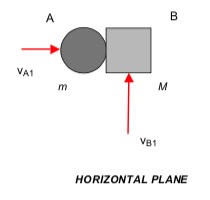| Problem statement Solution video |
DISCUSSION THREAD

Any questions?? Please ask/answer questions regarding this homework problem through the "Leave a Comment" link above.
Animation

HINTS:
STEP 1 - FBD: Draw three free body diagrams (FBDs): A, B and A+B.
STEP 2 - Kinetics: From the FBD of A, we know that it will continue to move along the same line of travel. In addition, the FBD of B shows that the t-component of velocity for B will remain unchanged, where the "t"-direction is tangent to the plane of contact of A and B. In the n-direction (perpendicular to the t-direction), you have both the linear-impulse equation and the coefficient of restitution equation.
STEP 3 - Kinematics
STEP 4 - Solve: Solve for M and e from your two kinetics equations above.
COMMENT: This problem is posed in a somewhat "backward" way as compared to many problems in impact. Typically mass and COR parameters are given, and we solve for final velocities. Here we are given some information on the final velocities, and we are asked to find mass and COR values. You use the same equations for either type of problem, you just solve these equations in a different way.
Is the Vb2 given to us as the magnitude of the velocity? If so, do we use that and what we know about the direction of Vb1 to find Vb2n?
I took v_b2 to be the magnitude and used it to solve for the n component of v_bn2 given that we know v_b1 is the t component of the v_b2
For part a.) to simplify the complexity of the final state having 2 components of momentum, start by making two equations: momentum in x for initial and final states and momentum in y for " ". For part b, the lecture book has a really good explanation on page 234.
You can use linear momentum in the y direction to find that Vby2 is equal to Vby1 and then use a 3-4-5 triangle to find Vbx2.
Make sure to find e with only the n-components of the velocities. In this case, I believe this is the x direction of the velocities.
Is the n component for e the n component for each body separately or for the the system as a whole?
In the COR equation, only the n-components of velocity are used. The numerator is the difference between the two individual n-components at "2", and the denominator is the difference between the two individual n-components at "1".
Despite the direction of vb2 not being provided, it is still relatively simple to find the the normal component of vb2. The vb2 value that is provided is the magnitude of vb2. Furthermore, it is important to note that the tangential component of vb2 will remain unchanged before and after impact, as only the normal component will be changed. With these 2 values known, it is straightforward to solve for vbn2.
While the direction of vb2 may not be specified, determining the normal component of vb2 remains a straightforward task. The given vb2 value represents its magnitude. It's crucial to emphasize that the tangential component of vb2 remains constant both before and after impact; only the normal component undergoes a change. Once these two values are identified, solving for vbn2 becomes apparent.
For this problem it is helpful to use the FBD of A and B and create linear momentum equations. Additionally, note the parameters given and leverage those to your advantage to help solve for the unknowns.
When solving for M, make sure to either set up your momentum equation with velocities in only the n-direction, or use the vector form of the velocities. I believe if you try to use the magnitude of velocity you will get an incorrect answer.
For this question, it is very important to understand that the y component of Vb2 is same as Vb1, as only the n or x axis component is getting impacted, therefore using this, the n component of Vb2 can be found using simple trigonometry.
The tangential path of sphere A does not change throughout this problem, so it is fair to assume that vA1,t and vA2,t are zero. In order to find vB2,n, you can use a 3-4-5 triangle and apply the components of the given values for vB1 and vB2.
The trickiest part of the problem I found was finding Vb2n. The best way to find this is to look at Vb2 in its magnitude form with Vb2^2=Vb2n^2+Vb2t^2